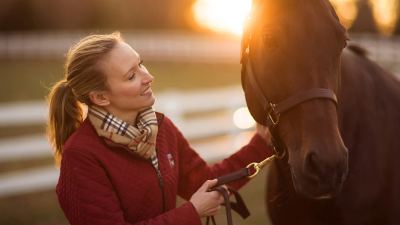Rotational grazing adds up to horse pasture payoff

Before you turn your horses out on grass, consider whether you are managing your pastures as effectively as possible.
If you’re in the Northern Hemisphere, with any luck, the chill of winter is finally lifting, and grass is taking on a long-awaited healthy, green glow. You and your horses are likely chomping at the bit (pun intended) to head outside and take full advantage of the free buffet. But before you turn those ponies loose, ask yourself: Are you thinking strategically about pasture management?
Why utilize rotational grazing?
If horses are allowed to graze on one pasture continuously, they can quickly eat down the quality forage, leaving behind weeds and potentially bare ground. Given the choice, horses will selectively graze on their favorite plants and grasses and may completely neglect certain areas while overgrazing others. Whenever a plant is grazed on, it needs time to regenerate leaves and restore energy to its root system. If grazed on again before roots are re-energized, the plant grows weaker. If regularly overgrazed, the plant will ultimately die. Rotational grazing is meant to stop this cycle from taking place.
By utilizing rotational grazing, you could potentially double the amount of forage produced and salvage this precious resource, thereby saving a great deal on additional hay costs. This is because rotational grazing allows portions of pasture to rest and recover, particularly the most heavily grazed plants and grasses. A pasture can be divided into several segments to allow ample time for rested areas to grow back to a reasonable grazing height.
How do I begin a rotational grazing program?
The way you divide your pasture(s) will depend on several factors, including climate, soil fertility, rainfall/irrigation, drainage, types of plants and grasses, and number of horses grazing. Removing horses from an area when the grass has reached an approximate height of 3 to 4 inches (using a color-coded grazing stick can be very helpful) can prevent overgrazing from occurring and allow you to take advantage of the underutilized sections.
If you are transitioning a paddock to its rest period, you will need to remove manure, trim to an even height to encourage grasses to regrow uniformly and allow approximately three to four weeks’ rest. You’ll need at least four paddocks (1 to 2 acres per horse, per paddock) to maintain this schedule. Using more will allow for briefer grazing periods and increased rest, which is even better. A smart strategy is to keep a dry lot available and feed hay when longer rest periods are warranted.
You may also be wondering how long you should allow horses to graze on pasture sections. This will be dependent on the number of horses, length of daily turnout and size of the area, as well as the other factors mentioned previously. A good rule of thumb is to plan for one week’s use of each section but to monitor closely. Walking the pastures, preferably daily, will allow you to ensure that areas aren’t being overgrazed and to check that fencing is working properly. Temporary electric fencing is generally most effective for this strategy as it can be adjusted at any time. It is also worth noting that you should keep horses inside or in a dry lot during wet weather to prevent pasture damage from hooves.
What about water?
One challenge associated with rotational grazing is that we are often using automatic waterers and the question of accessibility comes into play. Obviously, you won’t be able to provide easy access to the waterer in all instances, so you may have to get creative when it comes to providing adequate water. Setting up temporary troughs, checking them often and moving them around the paddock(s) periodically can help to avoid creating particularly muddy areas or soft ground, which could lead to pasture damage.
Is rotational grazing worth the hassle?
I know what you’re thinking. This sounds like a lot of extra work, and that’s because it is. But the time, effort and commitment can truly pay off in the end, with the potential to increase forage quantity and quality, improve horse health, save money (less spent on hay) and decrease both you and your horses’ environmental footprint, making rotational grazing a very worthwhile endeavor.















